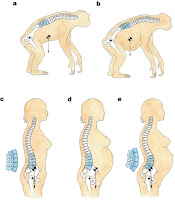Another great article from Brandon Morrison of Lift Big Eat Big
The Great Myth of the Core Workout
Add the word “core” to any form of exercise, and people seem to jump right on it. “Core blaster”, “Core fitness class”, “Sit on a ball at work to stabilize your core”. It is a buzzword that is thrown around so much it has become meaningless. It appears in every fitness dvd and boot camp on the market. Core training seems to have become another example of something that the masses will sign up for in order to get out of doing any real work.
First, let’s get started on the flawed training model of these core workout classes. Some of these classes can last up to 60 minutes and focus primarily on stretching, “core” exercises, and breathing patterns–all with the promise that you will have improved posture, better stability and of course, washboard abs.( Who doesn’t want those, right?). The first of many problems with these classes is their tendency to focus on concentric and eccentric contractions. In reality, most of the stability in our bodies is isometric.
Another problem with these classes are the claims that it will stabilize your body.
Grenier Kaycic has this to say about the complexity of trunk stabilization:
CONCLUSIONS: No single muscle dominated in the enhancement of spine stability, and their individual roles were continuously changing across tasks. Clinically, if the goal is to train for stability, enhancing motor patterns that incorporate many muscles rather than targeting just a few is justifiable.
The passive human spine is an unstable structure that requires stabilization by the co-contraction of trunk muscles. In the fitness industry, they are often mistakenly referred to as the “core”, implying that there is a distinct group of muscles for stabilizing. The transverses abdominis (TrA) is usually the muscle that is being mentioned. While it does play a role in stability, it is a role that is synergistic with every other muscle that makes up the abdominal wall.
A simple way to test the reliability of the stability help that TrA offers is on pregnant women. It takes the abdominal muscle 4-6 weeks to reverse the length changes and undergo re-shortening. Believing the core stability myth, it would seem that a women undergoing the changes of post-pregnancy would have severe lower back pain. Yet the study found that postpartum women women had unexpected speed in their recovery time. How is it possible that the lower back has been strengthened in a time when the abdominal wall is weakened?
The answer is that the relation between the abs and spinal stability has been dramatically exaggerated.
Not to mention that there is no evidence that proves that sitting on a ball at work is going to help improve your spine. If anything, it is going to relax your trunk even more. I’m not sure how it “forces your core to stay tight” as the claims say. You know what would make your back feel better at work? Getting up, walking around, and doing some air squats.

Getting back to the topic of fitness, ab-centric workouts have no place in the training regimen of a serious athlete. Any elite athlete will tell you that to build a strong core (core being everything between your neck and thighs), you have to work the compound lifts. Squats, presses, deadlifts, and the variations of the Olympic lifts will work your core in ways that you have only dreamed. I do abmat & GHD situps about twice a week, and my core is stronger than it ever has been. This is because I spend the majority of my workouts on compound movements with core exercises as a supplementation, not the main focus of my training.
Look at elite Crossfitters. Have you seen their stomachs? I don’t think they spend an hour doing 1/8 crunches on the BOSU ball. Besides, a 6 pack comes diet more than training.

| He uses the crunchercizer X-3000 |
Elite powerlifters and strongmen are squatting and deadlifting 800+ pounds. You think they are wasting time on those catapult-looking machines in the corner of the gym?
Stop wasting your valuable time in the gym focusing on your abs. All you have to do is work the compound lifts with excellent form, and your core will naturally strengthen along with everything else you are working. Abdominal definition will come from zoning in on your diet. You can do all the situps in the world and still have a gut if you are eating trash.
Just be a real (wo)man and keep lifting big. Only good things will come from it.
Sources:
Kavcic N, Grenier S, McGill SM. Determining the stabilizing role of individual torso muscles during rehabilitation exercises. Spine. 2004 Jun 1;29(11):1254-65.
Lederman, Eyal. PHD. The myth of core stability.
Hodges, P.W. and C.A. Richardson, Inefficient muscular stabilization of the lumbar spine associated with low back pain. A motor control evaluation of transversus abdominis. Spine, 1996. 21(22): p. 2640-50.
Hodges, P.W. and C.A. Richardson, Delayed postural contraction of transversus abdominis in low back pain associated with movement of the lower limb. J Spinal Disord, 1998. 11(1): p. 46-56.
Freeman, M.A., M.R. Dean, and I.W. Hanham, The etiology and prevention of functional instability of the foot. J Bone Joint Surg Br, 1965. 47(4): p. 678-85.
Jull, G.A. and C.A. Richardson, Motor control problems in patients with spinal pain: a new direction for therapeutic exercise. J Manipulative Physiol Ther, 2000. 23(2): p. 115-7.
Richardson, C.A., et al., The relation between the transversus abdominis muscles, sacroiliac joint mechanics, and low back pain. Spine, 2002. 27(4): p. 399-405

